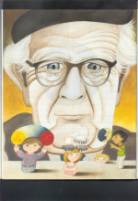| Constructivist Instruction Theoretical
foundation Contributions
|
Jean Piaget's theories: Cognitive Development in Children Piaget's examination of how thinking and reasoning abilities develop in the human mind began with observations of his own children and developed into a career that spanned some 60 years. He referred to himself as a "genetic epistemologist," or a scientist who studies how knowledge begins and develops in individuals. At least two features are widely recognized as underlying all of Piaget's theories: his stages of cognitive development and his processes of cognitive functioning. Piaget believed that all children go through four stages of cognitive development. Although the ages at which they experience these stages vary somewhat, he felt that each developed higher reasoning abilities in the same sequence: 1. Sensorimotor stage (from birth to about two years.) Children explore the world around them through their senses and through motor activity. In the earliest stage, they cannot differentiate between themselves and their environments (if they cannot see something, is does not exist.) Also, they begin to have some perception of cause and effect, and they develop the ability to follow something with their eyes. 2. Preoperational stage (from about age two to about age seven.) Children develop greater abilities to communicate through speech and to engage in symbolic activities such as drawing objects and playing by pretending and imagining; they develop numerical abilities such as the skill of assigning a number to each object in a group as it is counted. Children increase their level of self-control and are able to delay gratification but are still fairly egocentric and are unable to do what Piaget called conservation tasks (tasks that call for recognizing that a substance remains the same even though its appearance changes, e.g., shape is not related to quantity). 3. Concrete operational stage (from about age seven to about age eleven). Children's abstract reasoning ability and ability to generalize from concrete experiences increase, and they can do conservation tasks. 4. Formal operations stage (from about age twelve to about age fifteen). Children can form and text hypotheses, organize information, and reason scientifically. They show results of abstract thinking in the form of symbolic materials (e.g., writing, drama) Piaget believed that a child's development from one stage to another is a gradual process of interacting with the environment. Children develops they confront new and unfamiliar features of their environment that do not fit with their current views of the world. When this happens, he said, "disequilibrium" occurs that the child seeks to resolve through one of two processes of adaptation. The child either fits the new experiences into his or her existing view of the world (a process called assimilation) or changes that schema or view of the world to incorporate the new experiences (a process called accommodation). Though recent research has raise questions about the ages at which children's abilities develop and though it is widely believed that age does not determine development alone, Ormrod (2000) summarizes Piaget's basic assumptions about children's cognitive development in the following way: 1. Children are active and motivated learners. 2. Children's knowledge of the world becomes more integrated and organized over time. 3. Children learn through the processes of assimilation and accommodation. 4. Cognitive development depends on interaction with one's physical and social environment. 5. The processes of equilibration (resolving disequilibrium) help to develop increasingly complex levels of thought. 6. Cognitive development occurs in four qualitatively different stages, only after certain genetically controlled neurological changes occur. |
 Theoretical
foundation-Piaget
Theoretical
foundation-Piaget